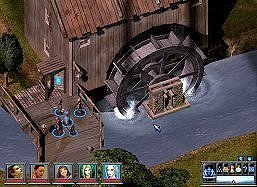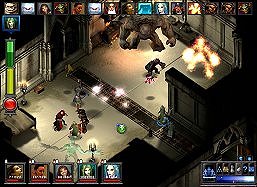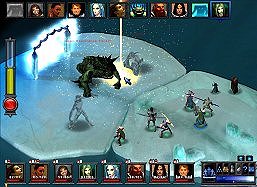|
The Temple of Elemental Evil
 This game sure starts off with a bang. The opening movie is so enticing. Thousands of grotesque creatures pouring through the doors of the Temple, storming across a darkened battlefield towards a waiting army. Dimension doors open high up on a ledge and cloaked magic users step out and rain down fireballs amongst the approaching enemy. The evil mob retreats in terror and finally, after a narrow escape, the arch demoness shuts the doors of the Temple of Elemental Evil once more.
After that taster I couldn't wait. But I had a long wait to play this game. Unfortunately it was released with enough demon bugs to stop me in my tracks. So I wouldn't even think about playing it without installing the patch although I know that many have successfully weathered the storm. Some of the bugs are just nuisance value, spells not working properly, NPCs misbehaving, etc., but I wasn't so lucky with regular lockups. Then came the patch and it worked like a charm ... This game sure starts off with a bang. The opening movie is so enticing. Thousands of grotesque creatures pouring through the doors of the Temple, storming across a darkened battlefield towards a waiting army. Dimension doors open high up on a ledge and cloaked magic users step out and rain down fireballs amongst the approaching enemy. The evil mob retreats in terror and finally, after a narrow escape, the arch demoness shuts the doors of the Temple of Elemental Evil once more.
After that taster I couldn't wait. But I had a long wait to play this game. Unfortunately it was released with enough demon bugs to stop me in my tracks. So I wouldn't even think about playing it without installing the patch although I know that many have successfully weathered the storm. Some of the bugs are just nuisance value, spells not working properly, NPCs misbehaving, etc., but I wasn't so lucky with regular lockups. Then came the patch and it worked like a charm ...
And speaking of charms, this game has just the sort of character creation to please anyone who likes to spend endless hours creating characters. You can play the game in either normal or ironman mode, and in the former mode you set out with up to five characters ... along the way three more will join you if you ask nicely and if their alignment is compatible.
Alignment is the first choice to make, there are 9 possibilities, and this then influences which of the pre-rolled characters you can decide to take. If you create your own characters, however, all the usual suspects are there to consider ... basic statistics (which you can roll and re-roll as many times as you like), race (7 choices), gender (only 2), class (10 choices), and too many feats and skills and spells (if applicable) to count. Plus there are choices relating to how your character looks and sounds.It can take quite a while to create your party, especially with all the tempting feats and skills to pick from. This is where some forward planning helps. For instance, if a character is going to specialise in ranged weapons and keep their distance during combat then the 'Dodge' feat might not be a good choice, but the 'Tumble' skill will come in handy for a Cleric who is going to be weaving in and out of harm's way and healing his or her companions. There are so many intricacies to ponder over. Just hover your cursor above each option in the various categories and you get a description of what benefits it brings. It's all very simple, the hard part is picking which one might be useful. A thorough read of the manual is a very good idea.
 The game starts out differently depending on the alignment of your party. You might witness a murder, identify the victim, and decide to deliver the bad news to the Church of St Cuthbert in Hommel. Alternatively you might accept a mission to chase up some bandits or, if you're evil, you might be seeking to destroy a particular artefact. As far as I could see these little starting interludes don't make much difference to the game other than set you one little chore to start with, and send you on your way to the village of Hommel where you begin your adventure.
This where you start chatting with the locals and perhaps doing favours to start earning experience. There are a multitude of quests but I must admit I wasn't too enthusiastic here. You can do things like play Cupid and get a couple together, play Romeo and woo a couple of the women, catch a couple of petty thieves, help someone get accepted into the town militia, or find converts for the church. Although they can get intertwined these quests are mostly solved by a lot of walking and talking. There are one or two more 'heroic' deeds to be done but for a while there I thought I was in a Soapie rather than a fantastic fantasy rpg.
I must admit this initial part of the game does get a bit mundane. Whilst you run around doing favours there doesn't seem to be any semblance of a game story lurking in the background, most locals aren't even aware that there's a problem with bandits let alone the worst that could be to come.
In fact The Temple of Elemental Evil is overall very light on story. Towards the end it picks up a bit when there are different factions involved and opportunities to play the game out in half a dozen or so different ways, but there certainly isn't a strong story line propelling you on. I suppose this is a plus for some players who don't like their games 'tarnished' with the smell of linearity, but I'm not one of them. I like to feel that I'm 'living' a story and that a lot of my deeds have purpose. In the scheme of things, when evil is lurking nearby and about to knock on your door, who cares if two people get together or not, surely "the problems of two little people don't amount to a hill of beans ..." The game starts out differently depending on the alignment of your party. You might witness a murder, identify the victim, and decide to deliver the bad news to the Church of St Cuthbert in Hommel. Alternatively you might accept a mission to chase up some bandits or, if you're evil, you might be seeking to destroy a particular artefact. As far as I could see these little starting interludes don't make much difference to the game other than set you one little chore to start with, and send you on your way to the village of Hommel where you begin your adventure.
This where you start chatting with the locals and perhaps doing favours to start earning experience. There are a multitude of quests but I must admit I wasn't too enthusiastic here. You can do things like play Cupid and get a couple together, play Romeo and woo a couple of the women, catch a couple of petty thieves, help someone get accepted into the town militia, or find converts for the church. Although they can get intertwined these quests are mostly solved by a lot of walking and talking. There are one or two more 'heroic' deeds to be done but for a while there I thought I was in a Soapie rather than a fantastic fantasy rpg.
I must admit this initial part of the game does get a bit mundane. Whilst you run around doing favours there doesn't seem to be any semblance of a game story lurking in the background, most locals aren't even aware that there's a problem with bandits let alone the worst that could be to come.
In fact The Temple of Elemental Evil is overall very light on story. Towards the end it picks up a bit when there are different factions involved and opportunities to play the game out in half a dozen or so different ways, but there certainly isn't a strong story line propelling you on. I suppose this is a plus for some players who don't like their games 'tarnished' with the smell of linearity, but I'm not one of them. I like to feel that I'm 'living' a story and that a lot of my deeds have purpose. In the scheme of things, when evil is lurking nearby and about to knock on your door, who cares if two people get together or not, surely "the problems of two little people don't amount to a hill of beans ..."
 If The Temple of Elemental Evil lacks in the story department it sure makes up for it with the wonderful turn based combat. This is where I was in my element because there's no rush, you can take your time to work out a strategy. Just right click on screen and this opens a radial menu for each character where the combat choices are many. There are various defensive or offensive moves for fighters; triple, double and single attacks, and charge attacks, for instance, not to mention all the spells for your spellcasters, and you can also choose to reposition your characters. For movement during combat a gauge to the left of screen tells you how much time there is but I mainly watched the colour coded cursor. Move it on the screen and if it stays green then your character can take their turn from that point, maybe cast a spell or fire an arrow, if not then their attack is forfeited.
If you have spellcasters then there are some impressive spell effects. Magic Missile sprays out missiles that ricochet around till you finally hear a 'thunk' when they hit their target. Other spells have appropriate light and sound effects too and you can see the affected zone of area effect spells so you don't cause any casualties from friendly fire. When you place protective spells on your party a little coloured tag above their portrait tells you the spell is current. Move the cursor over it and there is information about the duration. The same thing goes for disruptive spells cast on your party, only the tag is below the portrait. So you can't miss the fact that a character is confused or scared, although they are probably running away if it's the latter.
There are also spells available in this game for creating magical items, armour and weapons. It will cost your magic user in gold and experience to do this but the experience cap in the game is level 10, so if you don't leave it until you stop gaining experience points, you can experiment and make some useful stuff. There's plenty of time to replenish that experience.
And, of course, there are weapons as well as magic to deal with during combat so you can put your creations to good use. You can also make use of the handy system for organising your characters' personal armouries. For this purpose there are 5 slots available for weapon combos so once organised (just select the slot and equip items) then changing weapons is a breeze. The real bonus for me was that I didn't forget to equip a shield after using a bow. If The Temple of Elemental Evil lacks in the story department it sure makes up for it with the wonderful turn based combat. This is where I was in my element because there's no rush, you can take your time to work out a strategy. Just right click on screen and this opens a radial menu for each character where the combat choices are many. There are various defensive or offensive moves for fighters; triple, double and single attacks, and charge attacks, for instance, not to mention all the spells for your spellcasters, and you can also choose to reposition your characters. For movement during combat a gauge to the left of screen tells you how much time there is but I mainly watched the colour coded cursor. Move it on the screen and if it stays green then your character can take their turn from that point, maybe cast a spell or fire an arrow, if not then their attack is forfeited.
If you have spellcasters then there are some impressive spell effects. Magic Missile sprays out missiles that ricochet around till you finally hear a 'thunk' when they hit their target. Other spells have appropriate light and sound effects too and you can see the affected zone of area effect spells so you don't cause any casualties from friendly fire. When you place protective spells on your party a little coloured tag above their portrait tells you the spell is current. Move the cursor over it and there is information about the duration. The same thing goes for disruptive spells cast on your party, only the tag is below the portrait. So you can't miss the fact that a character is confused or scared, although they are probably running away if it's the latter.
There are also spells available in this game for creating magical items, armour and weapons. It will cost your magic user in gold and experience to do this but the experience cap in the game is level 10, so if you don't leave it until you stop gaining experience points, you can experiment and make some useful stuff. There's plenty of time to replenish that experience.
And, of course, there are weapons as well as magic to deal with during combat so you can put your creations to good use. You can also make use of the handy system for organising your characters' personal armouries. For this purpose there are 5 slots available for weapon combos so once organised (just select the slot and equip items) then changing weapons is a breeze. The real bonus for me was that I didn't forget to equip a shield after using a bow.
The graphics in Temple of Elemental Evil are pretty good although they are a bit dark at times. Your characters are small but you can see clearly when they swap weapons and armour. The spell effects are great and so is the music, I can hear it now as I write, accompanied by chirping crickets so it must be night time. The dialogue isn't that inspiring but this is probably more to do with a lack of a story and consequently the lack of strong characters in the game world. Luckily I don't have to complain about the missing descriptions for magic items because that has been fixed in the patch. So, apparently, has the problem with hired helpers who don't know when to stop looting and won't part with possessions so are eternally encumbered. Having installed the patch I tested this out at the end of the game with Taki and he still grabbed everything he could.
The game also has a map to which you can add notations and good log book for recording quests. This log also has a section named Ego with lots of fascinating trivia. Under 'Combat' you can see such things as who has had the most kills, the most consecutive hits or the most consecutive misses. My character with the lowest dexterity won that last race which was reassuring (and frustrating during the game when she had yet another miss!) The log book also has a section for Reputation which notes if you do good or bad deeds although this never influences your Alignment, which would have been good. As well as the log book there's a more 'meaty' book that you have access to at any time ... the help book. Here you can get lots of information and brush up on the D&D 3.5 Edition Rules if need be.
So although it started slowly this has been quite an enjoyable trip but not one of epic proportions. The combat is especially good, so for me the game picked up tremendously in the second part when you arrive at the Temple where there's more fighting to do. More story, though, would have gone a long, long way.
Copyright © Rosemary Young 2003.
All rights reserved.
System Requirements:
Minimum: Windows 98/ME/2000/XP, Pentium III 700 MHz, 128 MB RAM, 800 MB Hard disk space, 4x CD-ROM Drive, 16 MB Windows 98/ME/2000/XP - compatible 3D video card, Windows 98/2000/ME/XP compliant soundcard, DirectX: DirectX version 9.0 (included) or higher, Keyboard, Mouse.
Recommended: Windows 98/ME/2000/XP, Pentium 4 1.7 GHz or higher, 256 MB RAM, 1.2 GB Hard disk space, 10x CD ROM Drive, 64 MB Windows 98/Me/2000/XP-compatible 3D video card, Windows 98/2000/ME/XP DirectX certified sound card, DirectX version 9.0 (included) or higher, Keyboard, Mouse.
|
